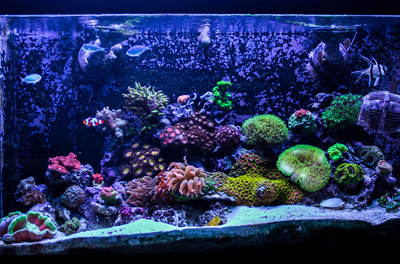Right now, I’m gazing at a magazine ad featuring the image of a reef tank, and the one word that comes to mind is “magnificent.” I’m sure you’ve seen one like it before, but allow me to describe it to you.
In this one tank, I can see all manner of soft and stony corals; sea apples; Tridacna clams; mushroom and zoanthid polyps; non-photosynthetic and photosynthetic gorgonians; giant feather duster worms; sponges; and various macroalgae—all packed together in a glorious riot of color.
And the fish! Captured in this image alone are schools (that’s right, schools!) of anthias, blue-green chromis, regal tangs, yellow tangs, and ocellaris clownfish. If you scan the image carefully enough, you might just spot royal and magenta dottybacks, a few royal grammas, various dwarf angelfishes, and maybe even Waldo peeking out from little niches.
So, what could be wrong with such a magnificent image? Sounds like the sort of tank we’d all be proud to possess, right? Well, not so much. In addition to “magnificent,” this (clearly doctored) ad image, while definitely eye-catching, brings another word to mind: “misleading.” What’s more, I worry that these types of images might just inspire hobby newcomers to take the wrong approach right off the starting block.
Here’s why:
Compatibility chaos
Let’s start with the corals. Cramming so many different coral varieties into such a tight space is sure to result in perpetual warfare, with specimens stinging, poisoning, digesting, overgrowing, or otherwise taking the fight to their cnidarian neighbors. Instead of a mélange of beautiful, healthy, fully expanded invertebrates, what you’ll actually see is a disappointing mix of contracted, injured, and dying/dead specimens, perhaps with a few of the more potent specimens holding sway.
As far as the fish are concerned, the idea of keeping schools of several different species in a modest-sized aquarium is simply preposterous. Also, I would never dream of combining some of the species they show as tankmates in the ad image. For instance, there’s no way those dottybacks would coexist peacefully with one another or put up with the royal grammas (or just about any of the other smaller fish, for that matter). There’d be no end of squabbling with this mix!
Biomass madness
If, by some miracle, the compatibility issues in such a system don’t cause mass casualties, the excessive bioload and its subsequent degradation of water quality certainly will. No amount of water changes, protein skimming, and chemical filtration could keep pace with the absurd bioload shown in these types of images.
Divergent care requirements
How does one provide proper lighting and water movement for a system that has low-light, gentle-current mushroom polyps situated inches away from a colony of high-light, high-current Acropora among other oddball pairings? The answer: you can’t.
What’s more, mixing filter-feeding inverts, such as non-photosynthetic gorgonians and sea apples, with photosynthetic clams and corals leads to all sorts of feeding/water-quality issues that would be challenging at best to contend with.
Don’t expect truth in advertising!
The takeaway from all this, especially for beginners, is that a reef tank built for long-term success looks nothing like the ones we often see in advertisements. In fact, falling far short of the bioload and livestock mix reflected in those images is actually a good thing!



